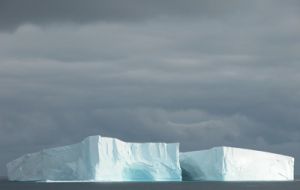MercoPress. South Atlantic News Agency
A Falklands area ice-block breaks off in Antarctica
 Giant icebergs
Giant icebergs A 14.000 square km ice block, almost the area of the Falkland Islands (12.173 sq. km.), has broken off Antarctica's Wilkins Ice Shelf and fragmented into smaller icebergs reported on Tuesday the Spanish National Research Council, CSIC.
The resulting giant icebergs, some of them 200 metres high are now drifting in the adjoining Antarctic sea. Scientists believe the ice shelf is crumbling as a result of global warming. A team of CSIC scientists on board the Spanish research vessel "Hespérides" has been in the area assessing the impact of the crumbling ice shelf on the Belinghausen Sea ecosystem, to the west of the Antarctic Peninsula. Over the past two weeks CSIC scientists have been following the Wilkins ice shelf evolution and have noted that water temperatures are "extraordinarily warm" in the area. CSIC scientist, Jordi Dachs, reported that his team had found "a very high level of bio-mass and biological production" in areas where the fragments of ice have gone and that there is "abundant fauna, with the largest concentration of humpback whales and leopard seals" they have seen so far in Antarctica. "We have also found very low levels of CO2 in the sea water, suggesting that the increase in sunlight as the shelf slimmed and elements released by the breaking ice fertilized the water", added Jordi Dachs. Pedro Luis de la Puente, captain of the Hespérides research vessel underlined the danger of sailing in these waters, which "have never been fully exposed to a topographic survey as they have been covered in ice up until now". The depth of the water is believed to range between 150 and 300 metres but scientists are encountering icebergs that have run aground suggesting different sea bed topography. The Wilkins ice shelf is to the southwest of the Antarctic Peninsula, 1.600 kilometres from the South American land mass. "Polar Year is coming to an end (March 2009) and unfortunately during this period the greatest proven and documented loss of ice mass on both polar caskets has been recorded by the different scientific teams, which is most dramatic", said CSIC researcher Carlos Duarte.




Top Comments
Disclaimer & comment rulesCommenting for this story is now closed.
If you have a Facebook account, become a fan and comment on our Facebook Page!